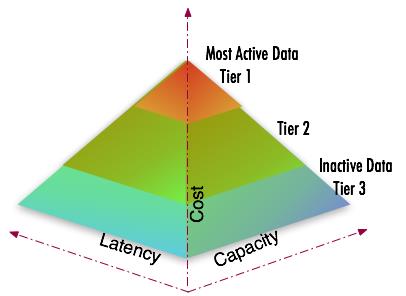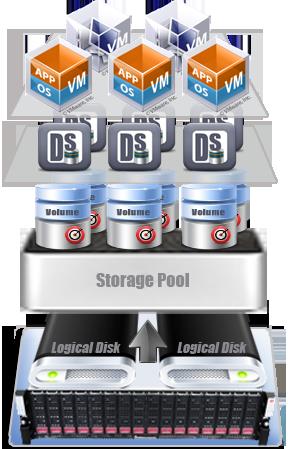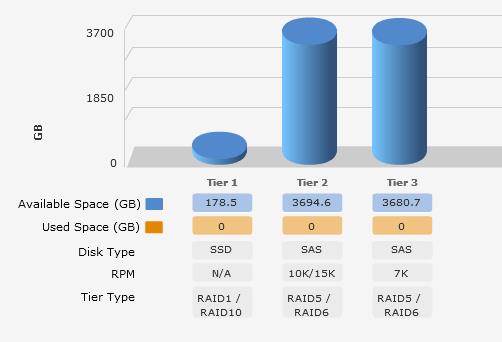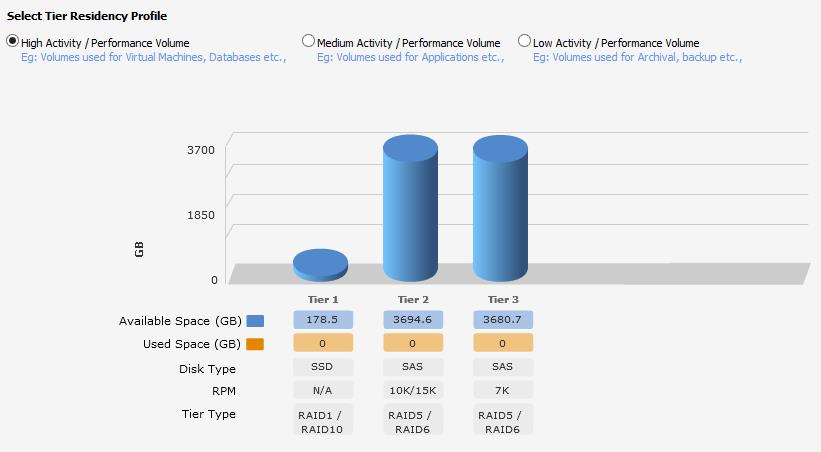Storage Industry has a high demand of both performance and Capacity now. At present, Solid State Drive (SSD) provides very good performance than any mechanical based Hard Disk Drive (HDD) like SAS or SATA. However, due to limitations in size of SSDs available in the market today, the demand for higher storage capacities cannot be met with SSDs alone. Earlier version of StorTrends including StorTrends iTX 2.7 on single controller hardware and older versions of StorTrends iTX 2.8 Stack running on StorTrends 3400i storage servers support tiered storage architecture. Newer versions of StorTrends iTX 2.8 supporting hybrid arrays with a mix of SSDs and HDDs are built around this tiered architecture and are designed to meet the demands and expectation of the customers of higher performance and larger capacity. However, the need for storage can be different for different purposes such as virtual machines, application servers such as Microsoft Exchange or database servers, or backup servers for archiving data for DR requirements and so will the need for performance. Keeping this in mind, data tiering in StorTrends iTX 2.8 running on StorTrends 3500i have been enhanced to a new level to support all the need of performance and capacity.

Figure 1. A Tiered Storage Architecture
In storage, a container or a logical volume combines of one or more logical devices. A tier is a group of logical drives of the same performance and protection characteristics. Cost is calculated based on the performance and latency of storing data in the drives involved in the logical device. In StorTrends iTX stack it is guaranteed that a logical device is created with same type of drives to give an equal performance from a logical device (RAID Array). A tier with a higher performance has lower cost. In earlier versions of StorTrends, data in a container was allocated from the highest tier itself regardless of types and number of tiers present in the storage. It was fully dependent on Information Lifecycle Management which is a fully automated data movement technology which is used to move aged data to lower tier.

Figure 2. StorTrends iTX Stack showing Logical Devices, Container, Volumes and their Usage
So, When a logical device with SSD drives is available in the storage for example, if a backup application where the performance demands are low, the space gets allocated automatically from the higher tier i.e., SSD Tier, whereas, the space for a high performance volumes such as some critical virtual machines would get allocated at lower cost tier like SAS or SATA as the space in the SSDs are hogged by low performance volumes.
StorTrends iTX2.8 has been enhanced to address the problem by allowing the user to decide the tier profile of the volume based on the performance requirement instead of deciding the tier based on the order of volume creation or provisioning or at the run time based on ILM. This feature, known as the Volume Tier Residency (VTR), seamlessly allows the user to control where the data need to reside, based on the requirement of performance, cost or application.
StorTrends iTX2.8 classifies volumes in to three profiles based on the IO activity on the volume
- High Activity/Performance volume - A volume which requires high performance and frequent IO such as Databases, Virtual Machine etc...
- Medium Activity/Performance volume - A volume which has medium level of IO activity such as volumes used for application data.
- Low Activity/Performance volume - A volume which does not requires high performance. Example volume which are used for backup, archival etc...
Based on the user-selected performance profile of the volume – high, medium or low – StorTrends decides the tier from which space allocation must be done when it receives the IO. StorTrends iTX storage architecture supports up to a maximum of 8 tiers in a container and VTR divides the 8 tiers in the following profiles:
- High profile tier: The highest available tier in the system
- Medium profile tiers: All the tiers except the first and the last
- Low profile tier: The lowest tier in the system

Figure 3. ManageTrends - Showing details about each tier
The medium profile tiers has all the tiers in the containers except the first and last. This is mentioned exceptionally because a container may not have all 8 tiers all the time.
The allocation of space follows the following sequence of allocation:
- High Profile - High -> Medium -> Low
- Medium Profile - Medium -> Low -> High
- Low Profile - Low -> Medium -> High (allocation in the medium also happens in the reverse order of the cost)
For example if there are all the 8 tiers available in the system, then the allocation in chain happens as follows for each volume profile:
- High - 0 -> 1 -> 2 -> 3 -> 4 -> 5 -> 6 -> 7
- Medium - 1 -> 2 -> 3 -> 4 -> 5 -> 6 -> 7 -> 0
- Low - 7 -> 6 -> 5 -> 4 -> 3 -> 2 -> 1 -> 0
ManageTrends has been enhanced to provide options to user to decide the volume profile during and after the volume creation. It also provides information about the available tiers and its details which helps the user to visually imagine the tiers in a container.

Figure 4. Volume Creation Page showing Options to Select Tier Residency Profile
It also provides graphical representation of tier with available space, free space, disk type used and RPM (If applicable) and tier type. This helps the user to visually understand the each tier current status and to plan accordingly. StorTrends iTX also provides the flexibility to move volume from any profile to any other profile after creation based on the current requirement on performance.
The benefit of Volume Tier Residency is the increase in the effective performance of the storage server. By giving the control of choosing the right performance level for the right application with the user, StorTrends enables the storage administrators in tuning the storage to the needs of each individual enterprise. StorTrends ILM works within the framework of VTR in moving the right data to the right tier thereby guaranteeing optimal performance for the applications based on the access patterns of data. With the benefits coming from the tiered storage with Volume Tier Residency, the storage stack not only gives required performance at demand but also helps to reduce the cost and power consumption behind usage of particular resources by optimally utilizing them.